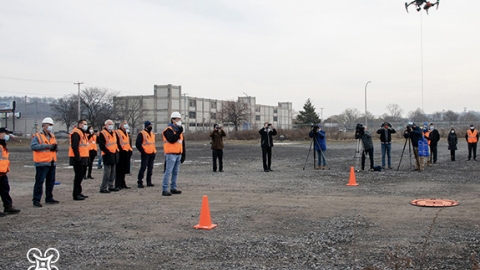Rigorous Training Requirements Adopted to Scale Drone Delivery One flight at a Time
This month, the team at DroneUp had the opportunity to be part of the COVID Humanitarian UAS Operation (CHURP) at The State University of New York’s (SUNY) Upstate University Hospital in Syracuse. Our goal was to build, test, and launch a safe, reliable, deployable, and scalable drone delivery program to respond to COVID-19. Our flight operation was a resounding success thanks to our partners’ efforts, the rigorous drone training for our pilots and flight team, and a flight operation plan that met the most stringent safety standards. So why was this test case so important?
This test case was the first time that DroneUp could fly a delivery operation over people and over moving vehicles anywhere in the US using industry-standard DJI drones. After seven months of negotiation with the FAA and working with our partners at Indemnis to prove our safety case, the FAA approved DroneUp’s 107.39 waiver, allowing us to conduct flights over people and moving vehicles. We tested our hardware and software configuration, developed and executed a rigorous training program for our flight team, tested our flight operation, and were good to go. The mission was a success.
The most critical component of our flight operation was the training that DroneUp conducted before the flight operation. Flights over people introduce a significant potential for risk to any drone operation. DroneUp’s pilot contractors must prove they are knowledgeable and proficient in overflight of people operations before operating under the waiver.
The initial knowledge-based training component requires students to understand the waiver’s specific limitations and procedures and demonstrate the drone and Indemnis’ parachute systems knowledge. Students attend a 3.5-hour webinar followed by a 30 question test before advancing to the practical training component.
The practical training component is a “check ride,” a flight that constitutes a final exam. We were thrilled to do the training at NuAir’s New York UAS test facility at Griffiss International Airport. The 2-hour practical test assesses students’ knowledge, flight performance, judgment, and decision-making skills against a criterion-referenced standard in 49 tasks across seven distinct functional areas. Pilots must pass all tasks satisfactorily before becoming qualified to fly over people. Failure of even a single task ends the test assessment.
This rigorous training for our drone package delivery program is the cornerstone of DroneUp’s risk management strategy. Human factors cause nearly 80% of all accidents. Organizations flying these complex missions must commit to the training necessary to mitigate risks and fly safely.
There has been a lot of hype around drone delivery companies. There are regulation hurdles, equipment challenges, and standard operating procedures that need to be standardized and deemed safe. Many envision a skyway for drones, but we still have a ways to go. We can see the future but, what can we do today?
Using DroneUp’s 107.39 waiver, we can do deliveries with increased efficiencies. We can also fly over people and moving vehicles for infrastructure inspections, commercial property inspections, mapping, and other high demand drone operations in populated areas. The drone no longer has to stop and wait for people and moving vehicles to pass by before resuming flight operations –increasing efficiencies tremendously and helps build a value proposition and cost justification for these operations.
So, what is on the horizon? We hope to deliver products where the delivery speed is critical for partners like SUNY. We were flying drones from Upstate Medical University’s heliport to their BioTech building 2300 feet away and back in 8 minutes. This mode of transportation is significantly faster than delivery by car. As you can imagine, drones provide significant benefits for delivery operations on campus and potentially nearby facilities at a medical center.
On Dec 28, 2020, the FAA released a final rule that allows for drones to fly over people, at night, and over moving vehicles without requiring operation-specific waivers. This rule creates four categories of drones that can operate over people based on the aircraft’s weight or kinetic energy transferred on potential impact. Some of these categories have simplified the ability to fly over people. Until the FAA provides approved test methods to validate the safety and compliance of UAS, it is difficult to estimate when these solutions will be viable on a standardized and scalable basis. Until that time, DroneUp will continue to use our 107.39 waiver and keep urging the industry forward safely, one flight at a time.
Learn more about DroneUp’s Training & Program Development here, or for more information about our flight services and products, contact us here.
Thank you to our CHURP partners and fellow drone enthusiasts on the SUNY project. CHURP is a team of experts with advanced UAS operations, telecommunications, public health, and public safety joined to establish, test, and launch safe, reliable, deployable, and scalable UAS operations to aid in response to COVID-19. The CHURP Team includes Emergent 121 Consulting, Akin Gump, LLC, NUAIR, DroneUp, NASA, L3 Harris, THALES, Crown Consulting, Inc., DroneResponders, The State University of New York’s (SUNY) Upstate University Hospital, SUNY Police Department, Airspace Link, Inc., BNSF Railway, and Skydio.
